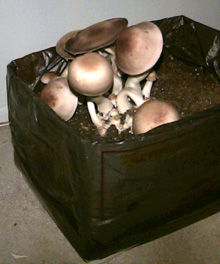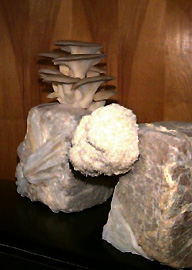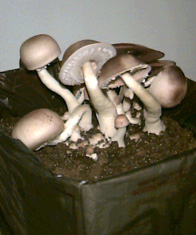









Dr. Bill Chapman, Soil Biologist, Cariboo Forest Region, Williams Lake, BC, Canada
My ultimate goal is to produce seedlings inoculated with Tuber melanosporum (black truffle) where your system is definitely going to help in the control of contamination. I have consistently been producing agar cultures, grain spawn and also used peroxide in the fruiting substrate to produce Oyster and Shiitake mushrooms with remarkable success considering the minimal infrastructure I have required to do so using your method.
Your system has taken the tedious part of mushroom growing away and the continuous battle in beating contaminants is considerably easier now using your method.
The cost of spawn in my area (South Africa) due possibly to monopolization is ridiculous and I am at the moment considering the possibility of producing spawn commercially using this method. Thank-you very much for making things a little bit easier."
Tabs Fox
Foxes Farming, Ficksburg, South Africa
I have also used the peroxide method in production of agar plates for the past year without the use of a glove box or HEPA filters. I have lost no more than 2 - 3% of my cultures due to contamination. I have grown Shittake, Oyster, and Ling Chi with the peroxide method."
J.B. Pelletier
Frederick, Maryland
It has proved excellent; [My wife] and I have grown both oyster mushrooms and shiitake to fruition on a beech-wood sawdust substrate enriched with bran and yeast with added lime. The beech sawdust I obtained from the coal-merchant as a kind of composite log about 2.25 inches in diameter...it has no peroxide-destroying activity. We used sunflower seeds as the spawn medium; much grown in Europe, and inexpensive...We used the peroxide method for the preparation of the agar plates...the spawn medium, and the final bulk substrate...
The shiitake tasted better than any other I have met with; dense and flavourful; much better than that bought from supermarkets. Colonization was fast and the 2.5Kg dry weight of substrate yielded a first flush of 1.1Kg of fresh mushrooms after 2 months.
So thanks for the peroxide method... I had tried mushroom growing before, but without the investment in expensive equipment the failures became dispiriting. Now the successes easily outnumber the failures."
David Wheldon
Bedford, UK
I must say I bought your book on a whim, and now I am kicking myself for not having done it sooner...Working in the kitchen caused me to throw out many many hours of work. No more...I have followed the complete cycle from spore to harvest 9 separate times now with ZERO contamination. For me that is not "just" a new record. It was a new record after doing it three times in a row!
Now like I said I wasn't new to this hobby. I have read most of the standard books on cultivation, but your manual had a few techniques I have never seen mentioned before. This info just isn't commonly known. Thank you so much. I would highly recommend this book to ALL mushroom growers."
Joshua Puchalski
Greenfield, Massachusetts
The idea of not being limited to the size of bags that can be processed in a retort (a giant pressure cooker) appeals to me. Species like Hericium and maitake can be found in the wild growing to tens of pounds. When cultivated on the heat-sterilized bags that weigh only 5 to 6 pounds, these species will have fruitings of only a pound per bag.
The wild mushrooms might have a whole log of several hundred pounds to draw nutrients from. So I've been interested in taking a huge amount of substrate (say 100 pounds) and processing it with Wayne's techniques and seeing what happens. His approach is limited only by the amount of substrate you wish to process, not the amount that can be heat-treated.
Consider ordering a copy of his manual. For hobbyists especially, it contains many useful approaches to tissue culturing...[The manual] can be purchased for about the price of a bag of spawn."
--Ralph Arnold, "You can sterilize substrates without autoclaving them," The Cultivation Column, Mushroom the Journal, Spring 1998, page 23.
I obtained some freshly innoculated spawn from a commercial supplier. Unfortunately their spawn..well, to put it simply ..it sucks! The mycelium is barely growing at all, in fact it almost seems like it's going dormant or degenerating. Anyway, out of curiousity I took a few rye berries with some noticeable mycelium growth and tossed 'em into a bottle of 10 min peroxide spawn. After just three days I could see obvious mycelium growth! After seven days a tight clump about 10 cm in size was present in the jar with no visible signs of contamination.
Now this mycelium had never been exposed to peroxide, and wasn't very vigorous to begin with...however,the peroxide spawn actually appears to have restored the vigor!"
Terry Parchem
Palos Park, Illinois
I like your stuff--it's well written and to the point...Plus your manual has many ideas I haven't found anywhere else on the use of readily available sources of substrate ingredients, such as organic cat litter, animal bedding and pellet stove fuel, all quite inexpensive and available at most pet stores and stove outlets. This has proven to be a real time saver for me not having to find those elusive connections for free sawdust and other recycled organic fibers!"
Bernie
St. Louis, Missouri.
Scott Bates
Webmaster, Arizona Mushroom Club
David Sar
Corona, California
Dave Cronk
Chandler, Arizona